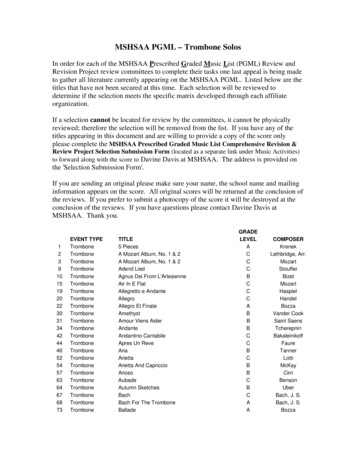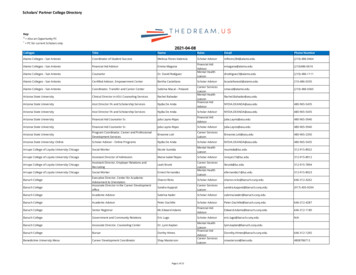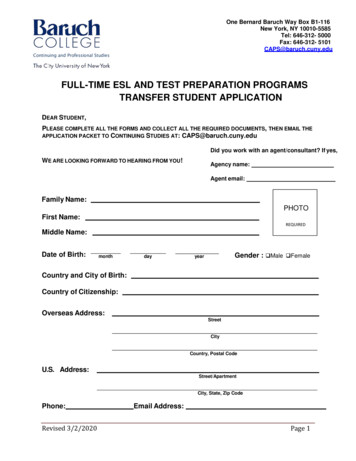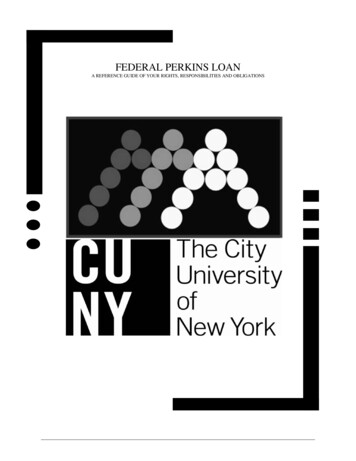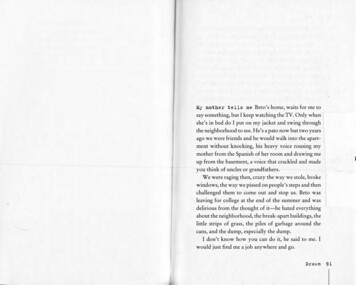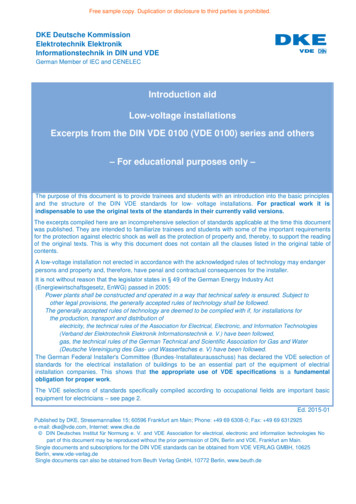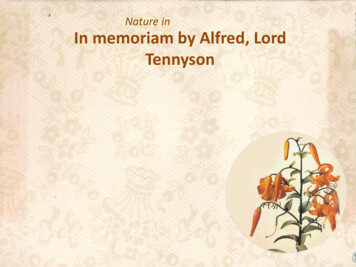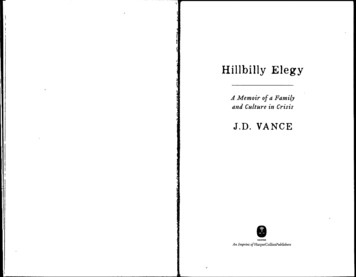
Transcription
Hillbilly ElegyA Memoir of a Familyand Culture in CrisisJ.D. VANCEfilHARPERAn Imprint 0/HarperCollins/’«Wishers
For Mamaw and Papaw, my very own hillbilly terminatorsCopyright 2016 by J.D. Vance. All rights reserved. Printed inthe United States of America. No part of this book may be used or reproduced in anymanner whatsoever without written permission except in the case of brief quotationsembodied in critical articles and reviews. For information, address HarperCollinsPublishers, 195 Broadway, New York, NY 10007.HILLBILLY ELEGY.HarperCollins books may be purchased for educational, business, or sales pro motional use. For information, please e-mail the Special Markets Department atSPsales@harpercollins.com.FIRST EDITIONDesigned by Leah Carlson-StaniskLibrary of Congress Cataloging-in-Publication Data has been applied for.ISBN: 978-0-06-230054-617181920ov/rrd30 29 28
iIIIIntroductionMy name is J.D. Vance, and I think I should start with a con fession: I find the existence of the book you hold in your handssomewhat absurd. It says right there on the cover that it’s amemoir, but I’m thirty-one years old, and I’ll be the first toadmit that I’ve accomplished nothing great in my life, certainlynothing that would justify a complete stranger paying moneyto read about it. The coolest thing I’ve done, at least on paper,is graduate from Yale Law School, something thirteen-year-oldJ.D. Vance would have considered ludicrous. But about two hun dred people do the same thing every year, and trust me, youdon’t want to read about most of their lives. I am not a senator, agovernor, or a former cabinet secretary. I haven’t started a billiondollar company or a world-changing nonprofit. I have a nice job,I)a happy marriage, a comfortable home, and two lively dogs.So I didn’t write this book because I’ve accomplished some thing extraordinary. I wrote this book because I’ve achievedsomething quite ordinary, which doesn’t happen to most kidswho grow up like me. You see, I grew up poor, in the Rust Belt,in an Ohio steel town that has been hemorrhaging jobs and hope
2J.D. VANCEHillbilly Elegy- 3for as long as I can remember. I have, to put it mildly, a complexStory. In our race-conscious society, our vocabulary often extendsrelationship with my parents, one of whom has struggled withno further than the color of someone’s skin—“black people,”addiction for nearly my entire life. My grandparents, neither of"Asians,” “white privilege.” Sometimes these broad categories arewhom graduated from high school, raised me, and few membersuseful, but to understand my story, you have to delve into theof even my extended family attended college. The statistics telldetails. I may be white, but I do not identify with the WASPs ofyou that kids like me face a grim future—that if they’re lucky,the Northeast. Instead, I identify with the millions of working-they’ll manage to avoid welfare; and if they’re unlucky, they’ll dieclass white Americans of Scots-Irish descent who have no collegeof a heroin overdose, as happened to dozens in my small home degree. To these folks, poverty is the family tradition—their an town just last year.cestors were day laborers in the Southern slave economy, share I was one of those kids with a grim future. I almost failedcroppers after that, coal miners after that, and machinists andout of high school. I nearly gave in to the deep anger and resent millworkers during more recent times. Americans call them hill ment harbored by everyone around me. Today people look at me,billies, rednecks, or white trash. I call them neighbors, friends,at my job and my Ivy League credentials, and assume that I’mand family.some sort of genius, that only a truly extraordinary person couldThe Scots-Irish are one of the most distinctive subgroups inhave made it to where I am today. With all due respect to thoseAmerica. As one' observer noted, “In traveling across America,people, I think that theory is a load of bullshit. Whatever tal the Scots-Irish have consistently blown my mind as far and awayents I have, I almost squandered until a handful of loving peoplethe most persistent and unchanging regional subculture in therescued me.country. Their family structures, religion and politics, and socialThat is the real story of my life, and that is why I wrote thislives all remain unchanged compared to the wholesale abandon book. I want people to know what it feels like to nearly give upment of tradition that’s occurred nearly everywhere else.” Thison yourself and why you might do it. I want people to under distinctive embrace of cultural tradition comes along with manystand what happens in the lives of the poor and the psychologicalgood traits—an intense sense of loyalty, a fierce dedication toimpact that spiritual and material poverty has on their children.family and country—but also many bad ones. We do not likeI want people to understand the American Dream as my familyoutsiders or people who are different from us, whether the differ and I encountered it. I want people to understand how upwardence lies in how they look, how they act, or, most important, howmobility really feels. And I want people to understand some they talk. To understand me, you must understand that I am athing I learned only recently: that for those of us lucky enough toScots-Irish hillbilly at heart.live the American Dream, the demons of the life we left behindcontinue to chase us.There is an ethnic component lurking in the background of myIf ethnicity is one side of the coin, then geography is the other.When the first wave of Scots-Irish immigrants landed in the NewWorld in the eighteenth century, they were deeply attracted to
4Hillbilly ElegyJ.D. VANCE-5the Appalachian Mountains. This region is admittedly huge—traits that our culture inculcates make it difficult to succeed instretching from Alabama to Georgia in the South to Ohio toa changing world.parts of New York in the North—but the culture of GreaterWhen I mention the plight of my community, I am often metAppalachia is remarkably cohesive. My femily, from the hills ofwith an explanation that goes something like this: “Of courseeastern Kentucky, describe themselves as hillbillies, but Hankthe prospects for working-class whites have worsened, J.D., butWilliams, Jr.—born in Louisiana and an Alabama resident—alsoyou’re putting the chicken before the egg. They’re divorcing more,identified himself as one in his rural white anthem “A Countrymarrying less, and experiencing less happiness because their eco Boy Can Survive.” It was Greater Appalachia’s political reorien nomic opportunities have declined. If they only had better accesstation from Democrat to Republican that redefined Americanto jobs, other parts of their lives would improve as well.”politics after Nixon. And it is in Greater Appalachia where theI once held this opinion myself, and I very desperately wantedfortunes of working-class whites seem dimmest. From low socialto believe it during my youth. It makes sense. Not having a jobmobility to poverty to divorce and drug addiction, my home isis stressful, and not having enough money to live on is even morea hub of misery.so. As the manufacturing center of the industrial Midwest hasIt is unsurprising, then, that we’re a pessimistic bunch. Whatis more surprising is that, as surveys have found, working-classhollowed out, the white working class has lost both its economicsecurity and the stable home and family life that comes with it.whites are the most pessimistic group in America. More pessimis But experience can be a difficult teacher, and it taught metic than Latino immigrants, many of whom suffer unthinkablethat this story of economic insecurity is, at best, incomplete. Apoverty. More pessimistic than black Americans, whose materialfew years ago, during the summer before I enrolled at Yale Lawprospects continue to lag behind those of whites. While realitySchool, I was looking for full-time work in order to finance mypermits some degree of cynicism, the fact that hillbillies like memove to New Haven, Connecticut. A family friend suggestedare more down about the future than many other groups—somethat I work for him in a medium-sized floor tile distributionof whom are clearly more destitute than we are—suggests thatbusiness near my hometown. Floor tile is extraordinarily heavy:something else is going on.Each piece weighs anywhere from three to six pounds, and it’sIndeed it is. We’re more socially isolated than ever, and we passusually packaged in cartons of eight to twelve pieces. My pri that isolation down to our children. Our religion has changed—mary duty was to lift the floor tile onto a shipping pallet andbuilt around churches heavy on emotional rhetoric but light onprepare that pallet for departure. It wasn’t easy, but it paid thir the kind of social support necessary to enable poor kids to doteen dollars an hour and I needed the money, so I took the jobwell. Many of us have dropped out of the labor force or haveand collected as many overtime shifts and extra hours as I could.chosen not to relocate for better opportunities. Our men sufferThe tile business employed about a dozen people, and mostfrom a peculiar crisis of masculinity in which some of the veryemployees had worked there for many years. One guy worked
6J.D. VANCEHillbilly Elegy7two full-time jobs, but not because he had to: His secdnd job atleast two other people, including Bob’s cousin, lost their jobs orthe tile business allowed him to pursue his dream of piloting anquit during my short time at the tile warehouse.airplane. Thirteen dollars an hour was good money for a singleYou can’t ignore stories like this when you talk about equalguy in our hometown—a decent apartment costs about fiveopportunity. Nobel-winning economists worry about the de hundred dollars a month—and the tile business offered steadycline of the industrial Midwest and the hollowing out of theraises. Every employee who worked there for a few years earnedeconomic core of working whites. What they mean is thatat least sixteen dollars an hour in a down economy, which pro manufacturing jobs have gone overseas and middle-class jobsvided an annual income of thirty-two thousand— well aboveare harder to come by for people without college degrees. Fairthe poverty line even for a family. Despite this relatively stableenough—I worry about those things, too. But this book issituation, the managers found it impossible to fill my ware about something else: what goes on in the lives of real peoplehouse position with a long-term employee. By the time I left,when the industrial economy goes south. It’s about reacting tothree guys worked in the warehouse; at twenty-six, I was by farbad circumstances in the worst way possible. It’s about a cul the oldest.ture that increasingly encourages social decay instead of coun few months before I did. Bob was nineteen with a pregnant girl teracting it.The problems that I saw at the tile warehouse run far deeperfriend. The manager kindly offered the girlfriend a clerical posi than macroeconomic trends and policy. Too many young mention answering phones. Both of them were terrible workers. Theimmune to hard work. Good jobs impossible to fill for any lengthgirlfriend missed about every third day of work and never gaveof time. And a young man with every reason to work—a wife-advance notice. Though warned to change her habits repeatedly,to-be to support and a baby on the way—carelessly tossing asidethe girlfriend lasted no more than a few months. Bob misseda good job with excellent health insurance. More troublingly,work about once a week, and he was chronically late. On top ofwhen it was all over, he thought something had been done tothat, he often took three or four daily bathroom breaks, each overhim. There is a lack of agency here—a feeling that you have littlehalf an hour. It became so bad that, by the end of my tenure,control over your life and a willingness to blame everyone butanother employee and I made a game of it: We’d set a timeryourself This is distinct from the larger economic landscape ofwhen he went to the bathroom and shout the major milestonesthrough the warehouse— “Thirty-five minutes!" “Forty-five min modern America.It’s worth noting that although I focus on the group of peopleutes!” “One hour!”I know— working-class whites with ties to Appalachia—I’m notOne guy. I’ll call him Bob, joined the tile warehouse just aEventually, Bob, too, was fired. When it happened, he lashedarguing that we deserve more sympathy than other folks. This isout at his manager: “How could you do this to me? Don’t younot a story about why white people have more to complain aboutknow I’ve got a pregnant girlfriend?” And he was not alone: Atthan black people or any other group. That said, I do hope that
8J.D. VANCEHillbilly Elegy-9readers of this book will be able to take from it an appreciationthe world. That’s the short version. The long version exists in theof how class and family affect the poor without filtering theirpages that follow.views through a racial prism. To many analysts, terms like “wel Though I sometimes change the names of people to protectfare queen” conjure unfair images of the lazy black mom livingtheir privacy, this story is, to the best of my recollection, a fullyon the dole. Readers of this book will realize quickly that thereaccurate portrait of the world I’ve witnessed. There are no com is little relationship between that specter and my argument: Iposite characters and no narrative shortcuts. Where possible, Ihave known many welfare queens; some were my neighbors, andcorroborated the details with documentation—report cards,all were white.handwritten letters, notes on photographs—but I am sure thisThis book is not an academic study. In the past few years,story is as fallible as any human memory. Indeed, when I askedWilliam Julius Wilson, Charles Murray, Robert Putnam, andmy sister to read an earlier draft, that draft ignited a thirty-Raj Chetty have authored compelling, well-researched tractsminute conversation about whether I had misplaced an eventdemonstrating that upward mobility fell off in the 1970s andchronologically. I left my version in, not because I suspect mynever really recovered, that some regions have fared much worsesister’s memory is faulty (in fact, I imagine hers is better thanthan others (shocker: Appalachia and the Rust Belt score poorly),mine), but because I think there is something to learn in how I’veand that many of the phenomena I saw in my own life existorganized the events in my own mind.across society. I may quibble with some of their conclusions, butNor am I an unbiased observer. Nearly every person you willthey have demonstrated convincingly that America has a prob read about is deeply flawed. Some have tried to murder otherlem. Though I will use data, and though I do sometimes rely onpeople, and a few were successful. Some have abused their chil academic studies to make a point, my primary aim is not to con dren, physically or emotionally. Many abused (and still abuse)vince you of a documented problem. My primary aim is to telldrugs. But I love these people, even those to whom I avoida true story about what that problem feels like when you werespeaking for my own sanity. And if I leave you with the impres born with it hanging around your neck.sion that there are bad people in my life, then I am sorry, bothI cannot tell that story without appealing to the cast of char to you and to the people so portrayed. For there are no villainsacters who made up my life. So this book is not just a personalin this story. There’s just a ragtag band of hillbillies strugglingmemoir but a family one—a history of opportunity and upwardto find their way—both for their sake and, by the grace of God,mobility viewed through the eyes of a group of hillbillies fromfor mine.Appalachia. Two generations ago, my grandparents were dirtpoor and in love. They got married and moved north in the hopeof escaping the dreadful poverty around them. Their grandchild(me) graduated from one of the finest educational institutions in
46J.D. VANCEFortunately, both Jimmy and Lori found their way. Jimmyworked his way through night school and landed a sales job withJohnson & Johnson. He was the first person in my family to havea “career.” By the time she turned thirty, Lori was working inradiology and had such a nice new husband that Mamaw toldthe entire family, “If they ever get divorced. I’m following him.”Unfortunately, the statistics caught up with the Vance family,and Bev (my mom) didn’t fare so well. Like her siblings, sheChapter 4left home early. She was a promising student, but when she gotpregnant at eighteen, she decided college had to wait. After highschool, she married her boyfriend and tried to settle down. Butsettling down wasn’t quite her thing: She had learned the lessonsI was born in late summer 1984, just a few months before Papawof her childhood all too well. When her new life developed thecast his first and only vote for a Republican—Ronald Reagan.same fighting and drama so present in her old one. Mom filed forWinning large blocks of Rust Belt Democrats like Papaw, Reagandivorce and began life as a single mother. She was nineteen, withwent on to the biggest electoral landslide in modern Americanno degree, no husband, and a little girl—my sister, Lindsay.history. “I never liked Reagan much,” Papaw later told me. “ButMamaw and Papaw eventually got their act together. PapawI hated that son of a bitch Mondale.” Reagan’s Democratic op quit drinking in 1983, a decision accompanied by no medicalponent, a well-educated Northern liberal, stood in stark culturalintervention and not much fanfare. He simply stopped and saidcontrast to my hillbilly Papaw. Mondale never had a chance, andlittle about it. He and Mamaw separated and then reconciled, andafter he departed from the political scene, Papaw never againalthough they continued to live in separate houses, they spentvoted against his beloved “party of the workingman.”nearly every waking hour together. And they tried to repair theJackson, Kentucky, would always have my heart, but Mid damage they had wrought: They helped Lori break out of herdletown, Ohio, had most of my time. In many ways, the townabusive marriage. They lent money to Bev and helped her withwhere I was born was largely the same as the one my grand child care. They offered her places to stay, supported her throughparents had migrated to four decades earlier. Its population hadrehab, and paid for her nursing school. Most important, theychanged little since the 1950s, when the flood of migrants on thefilled the gap when my mom was unwilling or unable to be thehillbilly highway slowed to a dribble. My elementary school wastype of parent that they wished they’d been to her. Mamaw andbuilt in the 1930s, before my grandparents left Jackson, and myPapaw may have failed Bev in her youth. But they spent the restmiddle school first welcomed a class shortly after World War I,of their lives making up for it.well before my grandparents were born. Armco remained the
48J.D. VANCEHillbilly Elegy— 49town’s biggest employer, and though troubling signs were on thein 1969, Uncle Jimmy’s senior year. (Even in 2003, Mamaw calledhorizon, Middletown had avoided significant economic problems.it the “new high school.”) The “rich” kids lived here. Large homes“We saw ourselves as a really fine community, on par with Shakermixed comfortably with well-kept parks and office complexes.Heights or Upper Arlington,” explained a decades-long veteranIf your dad was a doctor, he almost certainly owned a home orof the public schools, comparing the Middletown of yore to somehad an office here, if not both. I dreamed that I’d own a houseof the most successful of Ohio’s suburbs. “Of course, none of usin Manchester Manor, a relatively new. development not a mileknew what would happen.”from the high school, where a nice home went for less than a fifthMiddletown is one of the older incorporated towns in Ohio,of the price of a decent house in San Francisco. Next, the poorbuilt during the 1800s thanks to its proximity to the Miamikids (the really poor kids) lived near Armco, where even the niceRiver, which empties directly into the Ohio. As kids, we Jokedhomes had been converted into multi-family apartment units. Ithat our hometown was so generic that they didn’t even bother todidn’t know until recently that this neighborhood was actuallygive it a real name: It’s in the middle of Cincinnati and Dayton,two neighborhoods—one inhabited by Middletown’s working-and it’s a town, so here we are. (It’s not alone: A few miles fromclass black population, the other by its poorest white population.Middletown is Centerville.) Middletown is generic in other ways.Middletown’s few housing projects stood there.It exemplified the economic expansion of the manufacturing-Then there was the area where we lived—mostly single-familybased Rust Belt town. Socioeconomically, it is largely working-homes, with abandoned warehouses apd factories within walkingclass. Racially, there are lots of white and black people (the latterdistance. Looking back, I don’t know if the “really poor” areasthe product of an analogous great migration) but few others. Andand my block were any different, or whether these divisions wereculturally, it is very conservative, although cultural conservatismthe constructs of a mind that didn’t want to believe it was reallyand political conservatism are not always aligned in Middletown.The people I grew up around are not all that dissimilar frompoor.Across the street from our house was Miami Park, a single citythe people ofJackson. This is especially obvious at Armco, whichblock with a swing set, a tennis court, a baseball field, and a bas employed a plurality of the town’s population. Indeed, the workketball court. As I grew up, I noticed that the tennis court linesenvironment once mirrored the Kentucky towns that many offaded with each passing month, and that the city had stoppedthe employees came from. One author reported that “a sign overfilling in the cracks or replacing the nets on the basketball courts.a doorway between departments read, ‘Leave Morgan CountyI was still young when the tennis court became little more thanand Enter Wolfe County.’” Kentucky—down to its countya cement block littered with grass patches. I learned that ourrivalries—moved with the Appalachian migrants to town.neighborhood had “gone downhill” after two bikes were stolen inAs a kid, I sorted Middletown into three basic geographic re the course of the week. For years, Mamaw said, her children hadgions. First, the area surrounding the high school, which openedleft their bikes unchained in the yard with no problems. Now her
50Hillbilly ElegyJ.D. VANCE- 51grandkids woke to find thick locks cracked in two by dead-boltheyday, had a soda bar and served root beer floats. Across thecutters. From that point forward, I walked.street is a building that looks like a theater, with one of thoseIf Middletown had changed little by the time I was born,giant triangular signs that reads “STL” because the lettersthe writing was on the wall almost immediately thereafter. It’sin the middle were shattered and never replaced. If you need aeasy even for residents to miss it because the change has beenpayday lender or a cash-for-gold store, downtown Middletown isgradual—more erosion than mudslide. But it’s obvious if youthe place to be.know where to look, and a common refrain for those of us whoNot far from the main drag of empty shops and boarded-upreturn intermittently is “Geez, Middletown is not looking good.”windows is the Sorg Mansion. The Sorgs, a powerful and wealthyIn the 1980s, Middletown had a proud, almost idyllic down industrial family dating back to the nineteenth century, operatedtown: a bustling shopping center, restaurants that had operateda large paper mill in Middletown. They donated enough moneysince before World War II, and a few bars where men like Papawto put their names on the local opera house and helped buildwould gather and have a beer (or many) after a hard day at theMiddletown into a respectable enough city to attract Armco.steel mill. My favorite store was the local Kmart, which was theTheir mansion, a gigantic manor home, sits near a formerlymain attraction in a strip mall, near a branch of Dillman’s—aproud Middletown country club. Despite its beauty, a Marylandlocal grocer with three or four locations. Now the strip mallcouple recently purchased the mansion for 225,000, or aboutis mostly bare: Kmart stands empty, and the Dillman familyhalf of what a decent multi-room apartment sets you back inclosed that big store and all the rest, too. The last I checked,Washington, D.C.there was only an Arby’s, a discount grocery store, and a ChineseLocated quite literally on Main Street, the Sorg Mansion is justbuffet in what was once a Middletown center of commerce. Theup the road from a number of opulent homes that housed Mid scene at that strip mall is hardly uncommon. Few Middletowndletown’s wealthy in their heyday. Most have fallen into disrepair.businesses are doing well, and many have ceased operating alto Those that haven’t have been subdivided into small apartmentsgether. Twenty years ago, there were two local malls. Now onefor Middletown’s poorest residents. A street that was once theof those malls is a parking lot, and the other serves as a walkingpride of Middletown today serves as a meeting spot for druggiescourse for the elderly (though it still has a few stores).and dealers. Main Street is now the place you avoid after dark.Today downtown Middletown is little more than a relic ofThis change is a symptom of a new economic reality: risingAmerican industrial glory. Abandoned shops with broken win residential segregation. The number of working-class whites indows line the heart of downtown, where Central Avenue andhigh-poverty neighborhoods is growing. In 1970, 25 percent ofMain Street meet. Richie’s pawnshop has long since closed,white children lived in a neighborhood with poverty rates abovethough a hideous yellow and green sign still marks the site, so10 percent. In 2000, that number was 40 percent. It’s almost cer far as I know. Richie’s isn’t far from an old pharmacy that, in itstainly even higher today. As a 2011 Brookings Institution study
52J.D. VANCEHillbilly Elegy53found, “compared to 2000, residents of extreme-poverty neigh And why weren’t there enough well-paying consumers? Becauseborhoods in 2005-09 were more likely to be white, native-born,there weren’t enough jobs to employ those consumers. Down high school or college graduates, homeowners, and not receivingtown Middletown’s struggles were a symptom of everything elsepublic assistance.” In other words, bad neighborhoods no longer happening to Middletown’s people, especially the collapsing im plague only urban ghettos; the bad neighborhoods have spreadportance of Armco Kawasaki Steel.to the suburbs.AK Steel is the result of a 1989 merger between Armco SteelThis has occurred for complicated reasons. Federal housingand Kawasaki—the same Japanese corporation that makes thosepolicy has actively encouraged homeownership, from Jimmysmall high-powered motorcycles (“crotch rockets,’’ we calledCarters Community Reinvestment Act to George W. Bush’sthem as kids). Most people still call it Armco for two reasons.ownership society. But in the Middletowns of the world, home-The first is that, as Mamaw used to say, “Armco built this fuck ownership comes at a steep social cost: As jobs disappear in aing town.” She wasn’t lying: Many of the city’s best parks andgiven area, declining home values trap people in certain neigh facilities were bought with Armco dollars. Armco’s people sat onborhoods. Even if you’d like to move, you can’t, because thethe boards of many of the important local organizations, and itbottom has fallen out of the market— you now owe more thanhelped to fund the schools. And it employed thousands of Mid-any buyer is willing to pay. The costs of moving are so high thatdletonians who, like my grandfather, earned a good wage despitemany people stay put. Of course, the people trapped are usuallya lack of formal education.those with the least money; those who can afford to leave do so.Armco earned its reputation through careful design. “UntilCity leaders have tried in vain to revive Middlerown’s down the 1950s,” writes Chad Berry in his book Southern Migrants,town. You’ll find their most infamous effort if you follow CentralNorthern Exiles, “the ‘big four’ emjjloyers of the Miami ValleyAvenue to its end point on the banks of the Miami River, once aregion—Procter and Gamble in Cincinnati, Champion Paperlovely place. For reasons I can’t begin to fathom, the city’s brainand Fiber in Flamilton, Armco Steel in Middletown, and Na trust decided to turn our beauriful riverfront into Lake Middle-tional Cash Register in Dayton— had had serene labor relations,town, an infrastructural project that apparently involved shovel partly because they . . . [hired} family and friends of employeesing tons of dirt into the river and hoping something interestingwho were once migrants themselves. For example. Inland Con would come of it. It accomplished nothing, though the river nowtainer, in Middletown, had 220 Kentuckyians on its payroll, 117features a man-made dirt island about the size of a city block.of whom were from Wolfe County alone." While labor relationsEfforts to reinvent downtown Middletown always struck me asfutile. People didn’t leave because our downtown lacked trendyno doubt had declined by the 1980s, much of the goodwill builtby Armco (and similar companies) remained.cultural amenities. The trendy cultural amenities left becauseThe other reason most still call it Armco is that Kawasaki wasthere weren’t enough consumers in Middletown to support them.a Japanese company, and in a town full of World War II vets and
Hil
Hillbilly Elegy - 5 traits that our culture inculcates make it difficult to succeed in a changing world. When I mention the plight of my community, I am often met with an explanation that goes something like this: “Of course the prospects for working-class whites have worse

